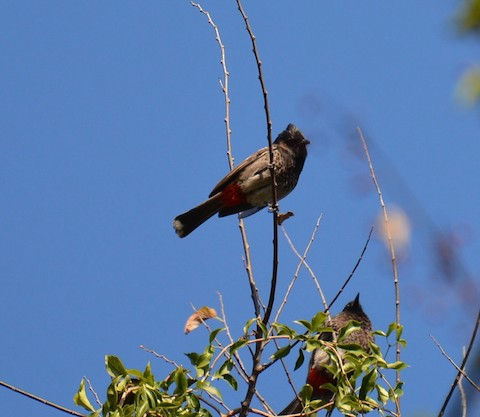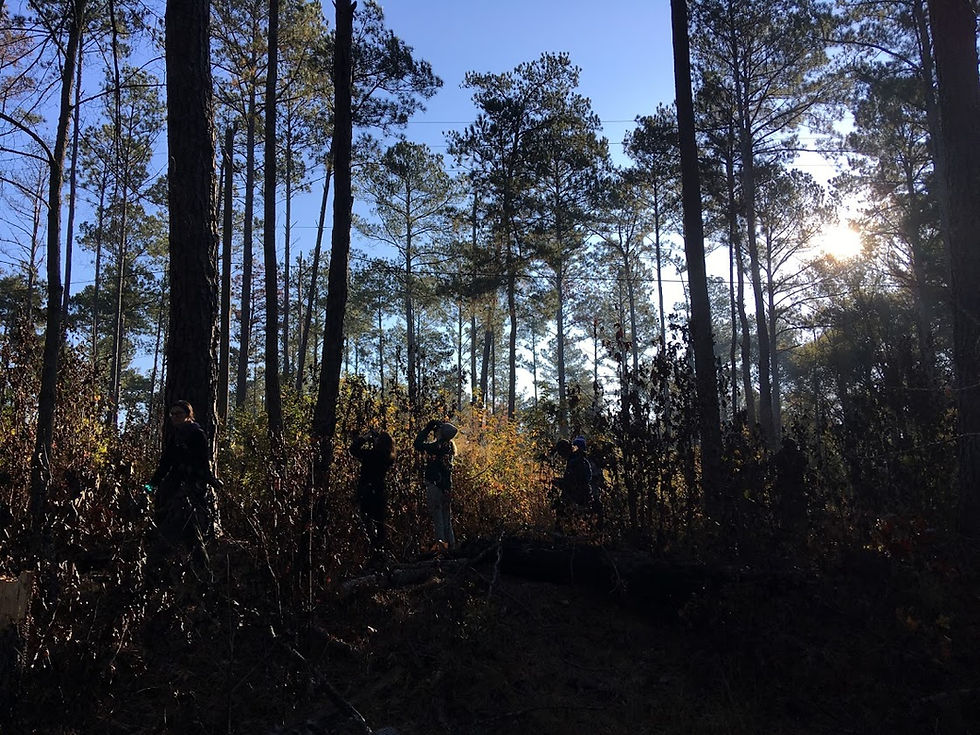Prairie Home Companions
- pnkleinhenz
- Oct 10, 2019
- 7 min read
If you are like Heather and I, conferences are tough. You're inevitably in a new place, with limited time, and all you want to do is get out and explore. The National Audubon Convention was no different. Heather and I attended a full day of programs on Saturday, and learned a ton of great information that we could take back to our respective chapters. I got to meet my mentee, Noah Poulos, who we got beers with at lunch. We met many cool people during breaks. But, in reality, all Heather and I wanted to do was to start birding.
After lunch, there were a couple of talks left but we decided we had to escape. We knew we would like Noah right away when he decided to come along. We piled into the rental car around 1:00 PM and immediately headed west.
So much planning goes into these trips since we always have a limited time to see a ton of species. On this trip, I wanted us to focus on the species we wouldn't be likely to see anywhere else. Following that line of thinking, our first destination was Zeloski Marsh, where we hoped to come upon the somewhat elusive Black Tern.
Zeloski Marsh really didn't look like much. We parked, surrounded by soybean fields, at the end of a deserted road. In front of us, a closed road let towards an overgrown shrubby field. This was supposed to have Black Terns? We weren't convinced, but we walked in and decided to hike the perimeter of the overgrown area. Very few birds were showing themselves and I was beginning to think that we had really wasted our time. The habitat looked degraded, it was hot, and time was of the essence. It was then that one of us saw a little flycatcher sallying from a tree. Noah, Heather, and I got our binoculars on it and Heather immediately said, "Maybe that's a Willow!" I wasn't so sure. Empidonax flycatchers are notoriously hard to identify. However, we realized that the bird was perched in a willow tree, matched the characteristics we had read about, and it was a species that had been reported there the day before. Still, none of us felt comfortable calling it. Then it called! We played a call to check and, sure enough, the call matched. Here was our first Willow Flycatcher of the year!
At least we had something. With the pressure off, we began to enjoy ourselves more. Cattails loomed in the distance, alerting us to the fact that a marsh actually existed here. With water came species. Before long, we had Wood Duck, Sandhill Crane, Common Yellowthroat, and a couple swallow species. But where were our terns? We saw something fly quickly by that seemed tern-like, but none of us could make out what it was. Time was running short and we needed to turn around. Fortunately, the turn around spot was near an area of extensive open water. We scanned again and, like it was planned, a tern appeared for each one of us as we scanned the water. All were juvenile Black Terns! We ended up seeing four in all, including one that was less shy and flew close by. Black Terns are occasional in Florida, but can be tough to both find and identify. With these, we had no doubt about their identity and got to watch them in their nesting habitat. I really enjoyed seeing these, and rank it as one of the more memorable "first birds" of the year so far.
The clock was ticking. We hiked the mile and a half back to the car, although we did have one interruption. A strange man appeared on the trail, although he never acknowledged us. When we approached closer, he turned and began to bushwhack into the forest. I gripped my binocular strap a bit tighter, in case I needed to do the 'ole bino swing to defend us in case he came back. Fortunately, we never saw him again.
We got to the car and had a drive ahead of us. We went straight west, covering the ground I covered extensively when I lived in Madison, Wisconsin a few years ago. We skirted Madison and began to penetrate the edge of the Driftless Region of the state, a part of Wisconsin that glaciers never touched. We noticed the ground change to limestone and I knew that we were getting close to the next destination.

Wisconsin, like many Midwestern states, once had huge expanses of prairie that stretched to the horizon. What many people don't realize is that intact Midwestern prairies are one of the most threatened ecosystems on Earth. The remnants that remain could not be more precious. One such remnant is Schurch-Thomson Prairie, a preserve owned and managed by a nonprofit land trust called The Prairie Enthusiasts. Late July was a great time to visit, since wildflowers were blooming and a breeze made the temperature pleasant.
We had very limited time at the prairie, since we needed to meet my friend, Olivia, at another stop shortly. However, we poked around the beautiful hillsides a bit and did see some birds. The most notable was our only new bird of a stop. We kept hearing a strange call and seeing a bird that we couldn't quite put our finger on. I was thinking Grasshopper Sparrow, but something didn't feel right. Heather played a series of calls and, we soon heard on her phone what we heard in the prairie...our first Henslow's Sparrow! This gorgeous bird has declined like crazy due to the loss of its prairie habitat, but clearly the species was doing fine here. We ended our short visit with five different individuals!

Now it was time to haul a**. We had 15 minutes to go 40 minutes. Most of you who know me know that I'm not always the best at keeping time in mind while exploring. The prairie had just been too gorgeous. I was planning to meet an old friend (and an ex-girlfriend at that) and was going to be late. We drove fast through the hilly topography that defines the Wisconsin River Valley and, somehow, only ended up being about 15 minutes late to Spring Green Preserve, our meeting site.
Olivia and I hugged, and we met her friend who came along for the ride. And then the exploration began. The Spring Green Preserve is called "Wisconsin's Desert" due to the extensive, sandy flats that have cactus growing up through them. High, limestone cliffs rise dramatically from the open prairie and, without a doubt, the habitat is one of the most unusual in the state. The diverse habitat, however, results in incredible species diversity, and not just for birds. The highest diversity of reptiles in Wisconsin can be found here, including glass lizards, ornate box turtles, and bullsnakes. Several tiger beetle species, rare plants, and unusual mammals round out the rich diversity here. But we were there to see birds.

Within moments of our arrival, we looked to a low oak rising out of the prairie. In it were some sparrows that I immediately recognized as a new one. They were the birds we came here to see: Lark Sparrows! Few sparrows top this one for looks, and we got great looks at three of them right off the bat. A strange, insect-like buzz alerted us to yet another new bird while we were admiring the Lark Sparrows. Heather and Noah immediately recognized the call, scanned with their binoculars, and were soon pointing out Heather and I's first Grasshopper Sparrow of the year! Two new birds in less than five minutes ain't bad!
I had read that both Eastern and Western Meadowlarks could be found here, but we struck out on Westerns in the open prairie. We hiked on, eventually entering a dense forest and a steep uphill climb to the top of the limestone bluff. It was here that we were assaulted. And, no, no creeper jumped out of the woods at us. We were assaulted by mosquitoes! My God were they awful! At one point, I was walking up ahead with Olivia and looked at her legs to see 8 or 10 mosquitoes on one of her legs. That motivated me to check my arms, where 5 or 6 mosquitoes were feasting. I looked back to see Noah, Heather, and Olivia's friend furiously swatting. We picked up the pace and made the bluff in record time.
The view was almost worth the mosquitoes. I spent some quiet, reflective times up on that bluff back when I was going through some difficult times back when I lived in Wisconsin. Being up there brought me right back into that reflective state. I began to think about the things I thought about then, and had to get up and walk around to avoid going too deep. It's amazing how places will have that effect on you. I walked for maybe 15 minutes and came back to find everyone in a reflective state, looking out over the Wisconsin River Valley that spread in front of them. It's a special place. As we looked out, we were even rewarded with our first Ruby-throated Hummingbird of the year! Not all of our birds are hard to work for. Some almost feel like rewards for the hard work we put in previously.

We ran the gauntlet of mosquitoes and reached the salvation of open prairie just before sunset. The group convened and discussed the plan. A man had passed us earlier in our hike and told us that he had heard Eastern Whip-poor-wills calling around sunset here within the past few days. Should we wait since we weren't hearing much, or should we head back? I think it was Noah who said, "Let's just give it ten or fifteen minutes." Ten minutes went by, nothing. Another minute, nothing. Another minute, nothing. Finally, we decided to throw in the towel. Bummer, we had missed them. Or had we? While we walked back to the car, Noah thought that he heard something. We turned our heads, cupped our ears, and listened. And there it was...the hauntingly beautiful call of the Eastern Whip-poor-will. I think that the events at the Spring Green Preserve offer a perfect summation of why we bird.







Comments